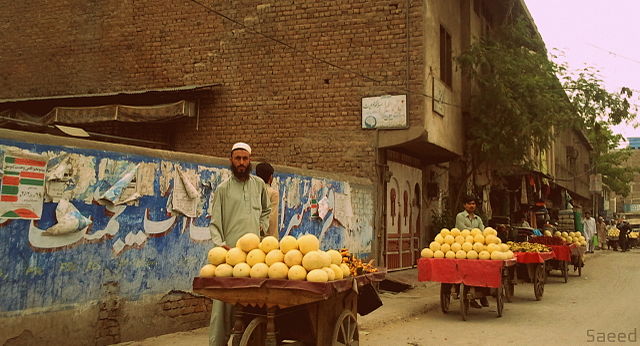This story was made with the collaboration of students from the University of Peshawar: Mashaal Ayaz, Amna Ehsan and Aamir Khaan.
Food is a necessity shared by human beings around the world. But it is also a reflection, and celebration, of culture. Western civilization is now known for its frenzied rush and quick meals, but Pakistan has a deep-rooted appreciation for food. People are more open to creating and growing their own ingredients, and stay flexible about what they consume- for the majority not taking part in stricter dietary requirements. It is also an assured way to spend time with family, with all members taking part in the making of a meal.

A number of fruit vendors in the city of Peshawar. Picture by Drsaeed90, 2012
Head of Social Anthropology at the University of Peshawar, Dr Mohammad Taieb, outlines the love of food in his own home country.
“Food culture means everything. Though, there is diversity in food culture as it changes geographically,” Dr Taieb said.
“For example, the people of Punjab use spicy food in their daily routine while Pushto speaking people use less spice.”
While Pakistan derives so many of its flavors from its history from when the country was still absorbed by India, it proudly bears its own national dishes, nuances, and trends.
A large influence on food culture in Pakistan is religion, as Pakistan is a primarily Islamic country. With this influence come dishes based on Halal, a method of preparing meats as per Muslim law; a not unheard-of concept in Australia with the 2016 census reflecting on a 2.6% Muslim population.
Many Pakistani dishes are not ones Melbourne would be unfamiliar with. Curries are made with colorful spices and meats such as mutton, lamb, goat and fish. They also sometimes include vegetables, and are nearly always accompanied by aromatic rice and crispy flatbread called roti.
With countries adopting and adapting to the accessibility of international ingredients, as well as Australia’s variety of cultures, Pakistani cuisine doesn’t seem as foreign as it once may have.
Students from the University of Peshawar, Aamir Khaan, Mashaal Ayaz and Amna Ehsan, discussed the favourite foods of their home city, especially a meal of ground meat formed into a patty and cooked with spices called Chappli kebab.
“We have many popular dishes. For Peshawari’s the most popular is Chappli kebab!” Mashaal said.
“We see Western influences in our fast food, mostly.” Aamir adds.
The students also talked about Punjabi and Pushtun culture, the two largest ethnic groups in Pakistan, and how food culture first grows within the home. The importance of sharing a meal with family and loved ones is a connection seen between Australia and Pakistan.
Recent figures show Melbournians are spending an average of $1,661 per year eating at restaurants, in Australia’s $24.3 billion dollar Café, Restaurant, and catering industry.
“Family meals have a great importance in Pakistan,” said Dr Taieb. “Most of the people prefer family meals- they do go outside but home meals are considered as a more balanced meal.”
But what is considered a balanced meal in Pakistani and Western living is a point of debate.

A wide variety of vegetarian based dishes are available in Pakistan. Picture by Shubert Ciencia, 2005
Despite Australia being declared to eat the most meat per person in 2014, the meat industry suffered a slight decrease in 2017 Both vegetarianism and veganism have become more popular in the West in recent years, for both perceived ethical and environmental reasons. But the food culture in Pakistan reflects a different point of view on cutting out food sources from the diet.
“Here is a totally non-vegetarian culture,” Ayaz said.
“People love meat.”
More people are eating meat and dairy due to a steady national income increase. As a result, the rates of people eating cheap meat free counterparts, such as pulses and legumes, have dropped in recent years. The Food and Agriculture Organisation of the United Nations found that the average consumption of pulses per person has fallen from 15kg to only 7kg annually.
Khaan said that meat is typically for the upper classes of Peshawar, while the middle class “cook normal vegetable, and pulses,” Khaan said.
“Which they normally use twice a day.”
With more people eating dairy on a regular basis, it’s also more common to create their own dairy products at home. While it is available at markets, “most people reject the market items due to chemicals”, according to Dr Taieb. But the food group is also susceptible to changes with the time of year.
“Dairy items have an interrelation with environment. Some dairy items are used in summer while others are preferred in the winter seasons.”
But, like many cultures around the world, there are no strict rules in what someone can or can’t eat. Ayaz said it’s the “same here in Pakistan,”
“People eat by their choice.”







